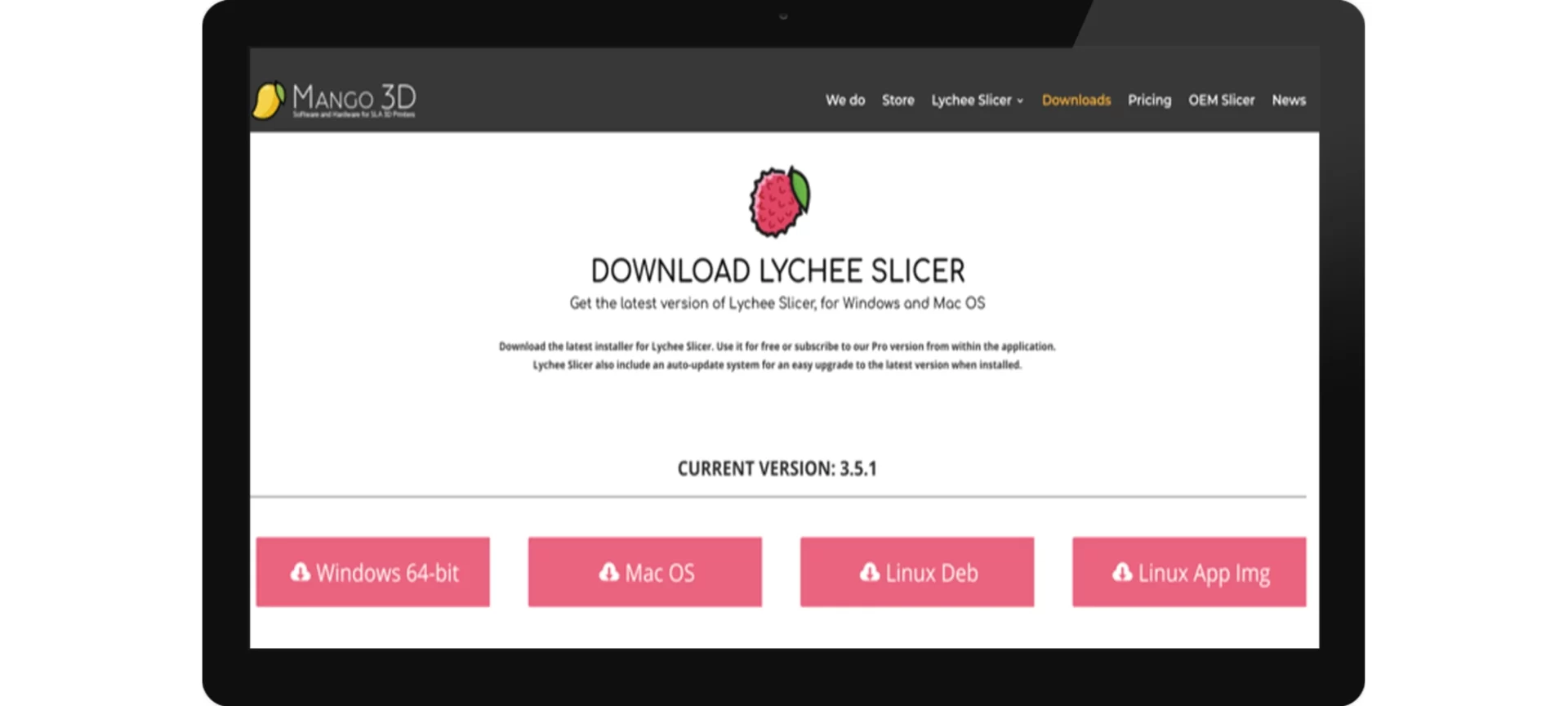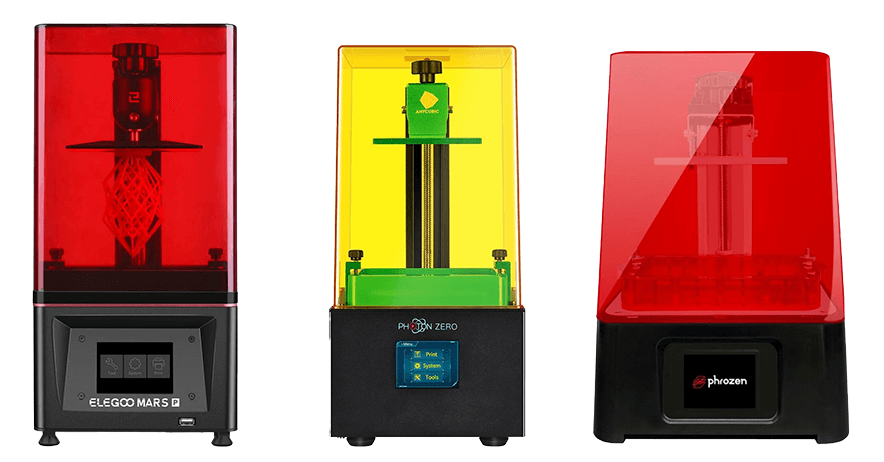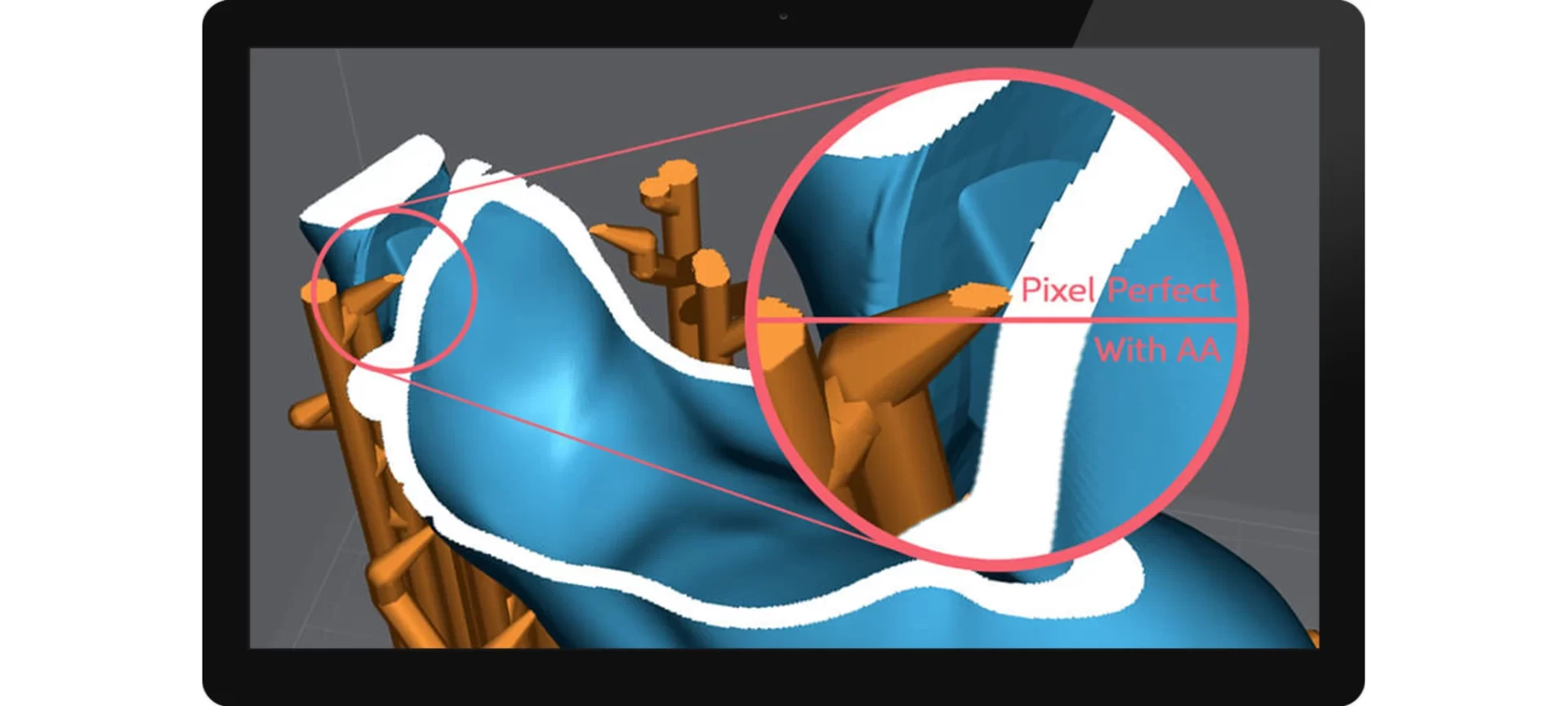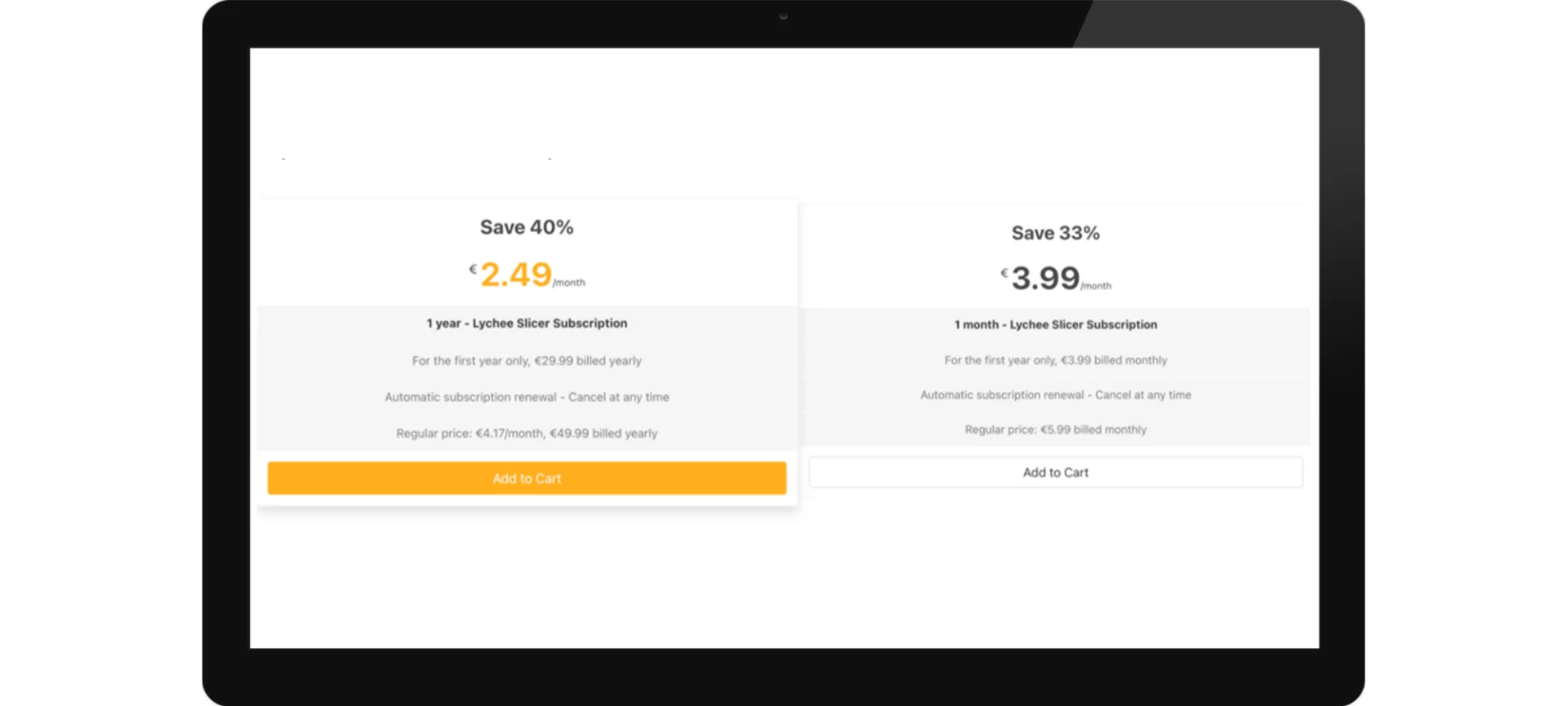Most of the slicers working in tandem with the popular FDM 3D printers, may not offer similar results with SLA-based machines. This is because the SLA printers create parts section by section, unlike FDM machines that work line by line for printing models.
Hence, the G-Codes that are positional-based aren’t compatible with the majority of the SLA printers. Thereby, generating the need for specific software that can help users slice models for printing with resin-based machines. And, Lychee 3D Slicer is one such application, offering great results when printing with photosensitive resin.
Lychee by Mango3D is created using the basic functions from the usual slicers, however, designed specifically for SLA 3D printers. The application is highly intuitive, providing professionals a one-stop solution for working with different brands of resin-based machines.
With amazing and premium features under its hood, the software does an exemplary job of creating automatic supports, raft placement, and various other tricks for perfect prints. In short, the application supports over 75 different SLA printers, ensuring that it caters to a larger user base with ease.
About Lychee 3D Slicer – Workflow

As mentioned, the slicer is designed keeping in mind the common workflow available with FDM applications. Hence, if you have worked with Cura and similar software before, getting acquainted with Lychee won’t be a hassle.
The workflow is divided into five major parts, where the printer setup is needed to be completed only initially when individuals work with the software the first time.
Printer Setup
The working of the slicer starts with the printer setup. You must complete the setting every time you add a new machine with the application. With support for 75 different printers, the process is pretty straightforward and requires minimum effort from the users.
In order to connect with the specific printer, just navigate while searching through the list of supported manufacturers. Finally, select the brand and model of your 3D printer. Along with the printer setup, you can also import or create custom profiles for resins depending on the material manufacturer.
Layout
Right after the setup completes, the application saves into the “Layout” view. This is where users can easily scale, add as well as orient models to the print bed. The layout view allows users to even repair their models while enabling many useful functionalities such as “Magic” and “Measure”.
Automatic Support Generation
Then comes the automatic support generation. Using the “Supports” view, it’s convenient to review the automatically generated support. In addition, users can also choose to build their own support, hollow out models as well as create rafts.
Those opting for automatic support generation don’t have to go through the manual process of building rafts and other procedures. However, the manual support generation ensures that the users expecting more advanced use cases get enough room to enjoy their creativity.
With a user-friendly interface, one can tweak and change the density, shape, diameter, and many other parameters of the supports, along with raft characteristics.
Print Preview
With the help of the “Preview” menu, you can review the prints for the final time before actually printing the 3D model. Mostly resembling the usual SLA applications, the Lychee 3D slicer ensures to add some unique features. For instance, its “Simulator” mode lets users visualize the parts while it prints.
Export
The workflow of Lychee 3D Slicer end with the “Export” menu. The function allows you to select your final print settings. Users can also preview the estimated print time.
Some find the options a little bit restricted especially when printing with advanced and dedicated printers. The export menu consists of a few choices such as selection of the type of resin, the anti-aliasing method, and a few more.
Lychee 3D Slicer – Features
Being one of the popular slicers, the application includes various standards as well as unique features.
Some Standard Features
Like many other SLA 3D Printer slicers, Lychee offers the basic functionalities expected by every other user. Here are some of the baseline features that you won’t like to miss exploring.
Support for Multiple Printer and Custom Resin Profiles

Lychee Slicer is an advanced application that comes with many perks for its users. Not designed for just one printer, but allows users to configure a custom SLA printer.
One must set up a Free Zone printer to get started with their choice of SLA machine. And, the process is very simple. Once you go through all the setup steps successfully, you can access the slicer’s functionality without any hassle.
When setting the Free Zone Printer, just remember, Lychee 3D slicer can’t create files directly that are compatible with the selected printer. Users must export the 3D file from the Lychee slicer to the application supported by the SLA printer.
In addition to the Free Zone printers, it’s also easier to create as well as import custom resin profiles. By filling in some specific details such as cure times, movement speed, layer thicknesses, etc., users can come up with custom profiles that fit directly to their printing needs.
Functions for Basic Manipulations
Once imported to the Lychee slicer, users can perform almost every basic manipulation on the 3D files like every other FDM or SLA application. For instance, Moving, Rotating, Scaling, & Mirroring.
Apart from the standard operations, the software also allows to undo and redo functions in order to deal with errors. In short, the complete functionality is clear and intuitive, offering users the utmost convivence while preparing the files for printing.
Generate Support Manually
Many advanced slicers offer automated as well as manual support generation functions. This is to ensure that the users can play around with wider use-case selections. And, Lychee Slicer is not different.
Using this application, users can opt to configure the support structure manually. It’s as easy as just selecting and clicking on the selected areas of the model.
When going for the Lychee Pro version, users get more options apart from the basic manual supports functionalities. The paid version comes with more choices for support shapes as well as methods for manual support placement.
Build-in Measuring Tool
Another feature that is very popular among the pro version is its Build measuring tool. The feature allows users to measure the supports’ distance one last time quickly before sending the 3D files for printing.
Instead of relying on the modeling tools for all the measurements, the Lychee Slicer makes it convenient to double-check the settings for best results.
Uncommon and Unique Features
To make the slicer a little more attractive than its competition, Mango3D has not shied away from adding a few unique features, not commonly found with SLA slicers.
Magic Mode
A very handy function for beginners, “Magic Mode” is just a one-click button job. The feature helps in adjusting the model’s (one or many) positions, orientation, support structure, and more.
In short, one can easily optimize the various settings automatically with just a click. Fascinating, isn’t it? And, the feature works with multiple models as well, loaded to the build plate.
Island Detector
Sometimes, users may miss out to place the support where needed. This is when the “Island Detector” feature comes in handy. Using the tool, users can automatically identify the places where the model requires additional support structures.
You may find a similar feature available with Firmware and ChiTuBox. But with Lychee’s detector, users can also customize these support structures according to their specific needs.
Something not possible with the other two alternatives. However, this feature is available for only paid users. Sadly, free users may have to lose out on most of the exciting features, available with the pro version.
Extra Setting Features

Apart from the major functionalities, the slicer also hosts some of the extra features that aren’t ‘must-haves’ when working with an SLA application.
For instance, real-time hollowing, drain hole generation, and infill creation. These functions are really impressive as it lets Lychee Slicer save cost on expensive resin while creating optimized yet strong prints.
Variable Layer Height
Although the function is supported by a handful of SLA 3D printers, the Lychee 3D slicer still includes it in its set of features.
By letting users optimize the layer height, the slicer helps in enhancing print times along with the quality of the parts. As far as we know, there is no other application apart from Lychee Slicer that offers this feature for SLA 3D Printers.
Once again, variable layer height is only available for pro version users.
Pixel Perfect Mode
The “Pixel Perfect Mode” further helps users in achieving high-resolution parts. Aiming to offer the highest level of precision, the Pixel Perfect setting slices the designs to fit the resolution of your machine. Hence, enabling high-quality 3D printing.
In order to use the feature, one must have a paid account. This is because the functionality is not available for free users.
Subscription for Lychee

If you are already excited to use the Lychee Slicer, there are three licensing versions you can choose from.
The first one is the free version. However, you must be ready to work with limited features. Most of the advanced and unique features aren’t available with this choice. But you still can perform the basic functionalities of the SLA 3D printer slicer. And, use it with over 75 different 3D printers.
There is just one problem when using the free version, the users may have to deal with ads in between the work. Otherwise, it’s a good choice for starters.
Along with the free version, users can also go with the two different paid options. With each of these paid versions, users can avail of a free 30-day trial.
With the no-contract monthly payments, users can get access to the complete features by paying around $5 each month. Alternatively, one can also choose the yearly option. This way, it’s easy to save a few bucks while paying around $3 monthly price for 12 months.
Mango3D Support
While the company is completely reliable, the support is a little limited in terms of reach. Lychee Slicer offers its paid customers email support. Also, the company does not mention the expected response times for the support emails. While this may work for a lot of users, some may find it really restrictive.
Apart from the email support, users can also check out their YouTube videos, specially designed to help users learn about the various features of the application. Simply by following the tutorials, one can understand the software workflow.
In short, there is enough information available online to help individuals with any obvious challenges faced when working with the application.
However, we do expect the company to come up with a stronger support base. It still does not have a strong community or it does not host any of the chat platforms for one-to-one communication.
The Conclusion
Definitely, the Lychee 3D slicer has all the ingredients to make it a complete software for 3D printing users working with SLA machines. It handles simple to advanced features with ease.
In addition, the user-friendly yet intuitive interface makes it easy to access the workflow without any hassle. Overall, it offers a great working experience to its users.







